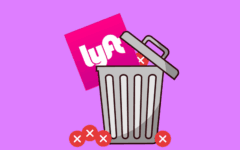
In case you haven’t heard, taxi industries in the United States and beyond are being turned upside-down by ride-sharing systems such as Uber and Lyft. These are two of the hottest mobile apps for requesting a ride to anywhere you need to go, but which one is right for you? To help you decide, we’ll look at the core features of these two ride-sharing apps side-by-side, and then discuss how they stack up depending on what your needs are. In this article, we’ll cover:
- What is a ride sharing app and how do they work?
- What makes ride sharing apps different than taxis
- Who wins: availability and accessibility
- Who wins: price
- Who wins: safety
- The bottom line: what’s the right ride-sharing app for you?
Read on to get the final verdict on whether Uber of Lyft is better for you.
What is a ride-sharing app and how do they work?
Already familiar with how ride-sharing apps work? Click here to jump ahead to the Uber vs. Lyft showdown.
A ride-sharing app is a program for mobile smart phones that facilitates semi-freelance taxiing. Passengers can use the app to request a taxi, specify pick-up and drop-off points, and pay when the ride is over. Drivers, meanwhile, can use the app to accept taxi requests and get paid once their fare is up.
Ride-sharing apps like Uber and Lyft, emerged primarily in the late 2000s and early 2010s as a response to perceived inefficiencies in traditional taxi services. For instance:
- Having to wait for a taxi assigned to a specific area to show up could cause it to be late – or even not arrive at all.
- Passengers would often be forced to meet taxis at places in their area or on their routes, which could be a significant distance away or in a traffic-heavy (or otherwise unsafe) part of town.
- If a passenger wanted to go somewhere outside of a driver’s regular area or route, it could take extra time, as the driver may be unfamiliar with the area and may need help with directions. And that would result in a higher fare, too.
Ride-sharing apps take advantage of advancements in Internet, mobile phone, and GPS technologies to solve these problems, recruiting everyday drivers to taxi people from anywhere to anywhere else, anytime, at their convenience. How does it all work? We’ll explain that right now!
How ride-sharing apps work in practice
First, a passenger sends a ride request out to drivers in an area. When a driver accepts the request, they drive to the pick-up point and get the passenger. When the passenger reaches their destination, the driver charges the fare to their credit card, which is set up beforehand through the app.
This may sound similar to how traditional taxi and limousine services work. And in some ways, it is, but there are quite a few ways these apps are an improvement on standard taxi services.
What makes ride-sharing apps different from regular taxis?
If you already know, click here to jump down to our comparison of Uber vs. Lyft.
Ride-sharing apps have a lot of features that regular taxis don’t. For instance, you can specify exactly where you want to be picked up and dropped off, so the driver knows where you are and where you’re going ahead of time. You can even get an estimate on how much your ride will cost you before you submit your request for a driver!

Another neat feature of these apps is that they let you see exactly who is picking you up, including what they look like, what kind of car they’re driving, and what their license plate number is. This is an important safety feature, because access to their personal information will help you in any negative situation that might arise.
They also give you an estimate of how far away the driver is. So you can get in the right car at the right time, every time! You don’t have to worry that your driver will never show up, because you can track where they are as they are en route. In addition, drivers are penalized for cancelling or not showing up for an accepted ride, so chances are – barring some kind of serious emergency – they’re going to be there for you.

Once your trip is done, you can rate your driver, and sometimes, even tip them too! This lets you reward drivers for friendly and expedient service, or warn other passengers about a poor driver who’s none too friendly or doesn’t seem to have a good grasp on navigation. Remember that your driver can rate you, too, so be on your best behavior!

Now, we’ll look at how two of the most popular ride-sharing apps, Uber and Lyft, stack up against each other.
Who wins: availability and accessibility
Uber is a worldwide enterprise now, serving over 665 cities and regions around the globe. You can find a full list of places where it’s available here, but the following is an overview of its reach:
- Over 275 major American cities, along with around 15 major cities in Canada
- Over 140 cities in Central America and South America
- 95 cities in Europe
- Over 40 cities in Southeast Asia
- Over 35 cities in South Asia
- 20 cities in Australia and New Zealand
- 15 cities in Africa
- Over 10 cities in the Middle East
- About 10 cities in East Asia
Lyft, on the other hand, constrains its business to United States territories only. But that doesn’t mean it isn’t anywhere near Uber’s scale when it comes to the size of its business. Whereas Uber bills itself as being available in over 275 places in the United States, Lyft is available in over 615 American cities and regions! For a complete list of its nationwide availability, click here.
One other thing to note is that Uber has specialized cars and drivers available for people who need to use wheelchairs or who require extra assistance. Lyft asks their drivers to be accommodating to people with accessibility issues, but do not advertise having special cars or drivers for them.
Key takeaways: Uber has more of a worldwide reach, while Lyft is more readily available to those in the United States.
Winner: Uber
This one isn’t quite as straightforward as it seems, because we’re kind of comparing apples to oranges. Lyft has a much bigger presence in the United States than Uber does, but that’s because Lyft only operates there (at least for now). Uber, meanwhile, has spread its availability out across all five major continents. In terms of sheer numbers, though, you can find Uber in more places than you can find Lyft.
Uber also has more options for rides, including official vehicles in its fleet for those with wheelchairs or other accessibility issues. While Lyft asks their drivers to be accommodating as possible to these people, they don’t have anything official for them. Add it all up, and Uber takes this one.
Next, we’ll look at how friendly (or not) these two ride-sharing services are to your wallet.
Who wins: price
Lyft and Uber both use dynamic pricing models that are based on the traditional taxicab system. So, where you use them, how far you go, and how long it takes to get where you want to go all play a role in how much you have to pay for your trip. In addition, both have different tiers of service (basically representing the class of vehicle you get to ride in), so those can factor into your cost as well. And so can Uber’s “Surge Pricing” or Lyft’s “Prime Time Pricing”, which can really increase the cost of your fare if there aren’t enough drivers in an area to meet the demand for rides.
With all that said, let’s crunch the numbers. Here’s a table of how much Uber fares cost for each of its main tiers of service in San Francisco, California, U.S.A.:
| Service Tier | Base Fare | Booking Fee | Per-Minute Cost | Per-Mile Cost | Minimum Fare |
|---|---|---|---|---|---|
| UberX | $2.00 | $2.00 | $0.22 | $1.15 | $7.00 |
| UberXL | $3.00 | $2.25 | $0.30 | $2.00 | $9.25 |
| UberSelect | $5.00 | $2.25 | $0.50 | $2.75 | $11.25 |
| UberBlack | $8.00 | N/A | $0.65 | $3.75 | $15.00 |
| UberSUV | $15.00 | N/A | $0.90 | $3.75 | $25.00 |
And here are Lyft’s prices in San Francisco:
| Service Tier | Base Fare | Booking Fee | Per-Minute Cost | Per-Mile Cost | Minimum Fare |
|---|---|---|---|---|---|
| Lyft | $2.00 | $2.00 | $0.22 | $1.15 | $5.00 |
| Lyft Plus | $3.00 | $2.25 | $0.30 | $2.00 | $7.00 |
| Lyft Premier | $5.00 | $2.25 | $0.50 | $2.75 | $9.00 |
| Lyft Lux | $8.00 | $1.75 | $0.65 | $3.75 | $15.00 |
| Lyft Lux SUV | $15.00 | $1.75 | $0.90 | $3.75 | $25.00 |
Key takeaways: Prices are quite similar in major cities, though Lyft’s minimum fares are slightly lower for basic services. So, if you frequently take short trips, it could be to your benefit to use Lyft.
Winner: Lyft
Both Uber and Lyft are pretty competitive when it comes to pricing. However, Lyft has an advantage in that it has slightly lower minimum fares than Uber does, at least for its lower-tier services. If you’re looking to be thrifty, then Lyft is usually the cheaper choice. A price comparison from 2015 showed Lyft’s average fare price across all its services was about $18, while Uber’s was about $24. Lyft, therefore, ekes out a narrow victory here.
Lastly, we’ll look at how far Uber and Lyft go to keep you safe in your travels.
Who wins: safety
Both Uber and Lyft – and ride-sharing services in general – have been scrutinized by government agencies, taxi companies, and sometimes passengers themselves over their safety, privacy, and other regulatory standards. In response, they have both implemented common tools and practices for keeping their passengers and drivers safe. These include user databases, anonymous contact, mutual rating systems, reporting systems, insurance policies, background and vehicle checks, and community guidelines.
Here’s a side-by-side comparison of some of the details of their safety policies:
| CRITERION | UBER | LYFT |
|---|---|---|
| Driver Age & Experience | ||
| Driver Background Check | ||
| Driver D.M.V. Check | ||
| Vehicle Check | ||
| Insurance Coverage |
In addition to all this, Uber’s guidelines for riding safely can be found here. We also recommend having a look at our overviews of Uber safety and Lyft safety.
Key takeaways: Minimum safety requirements are mainly the same, though Lyft is slightly stricter in some cases.
Winner: Lyft
Again, this isn’t quite a clear-cut comparison. Uber generally has better insurance policies and stricter regulations on what kinds of vehicles can be used in its fleet, so its emphasis is on making sure rides are safe overall. Meanwhile, Lyft generally has stricter standards for who can actually become a driver for them, so it prioritizes the safety of its passengers first. So, then, which approach is better?
Well, Lyft’s strategy of building trust both inside and outside its community of riders and drivers has worked out pretty well. Stricter criminal record and D.M.V. checks – along with a zero-tolerance drug and alcohol policy – have ensured that Lyft has received very few complaints about the safety of rides and conduct of drivers.
Uber, meanwhile, has been the subject of a few high-profile complaints regarding drivers allegedly sexually assaulting passengers or committing other crimes. As such, their “catch-all” safety policy has received criticism for allegedly not paying enough attention to adequately screening their drivers and (thus) keeping their passengers safe.
On average, both Uber and Lyft are about as safe as traditional taxicabs – and perhaps more so – as long as you use the tools available to you properly. In a head-to-head comparison, however, Lyft goes the extra mile to keep its customers safe, which is probably what you’re most concerned about. So we’re giving this one to Lyft.
The bottom line: what’s the right ridesharing app for you?
Why choose Lyft?
If you’re looking to get a ride somewhere inside the United States and you’re looking to save as much cash as possible, then Lyft is superior to Uber. It’s available in over twice as many places across the U.S. as Uber is, and has lower minimum fares for its non-luxury services. This makes it useful if you’re covering short distances within a particular city, whether you’re a tourist seeing the sights or just need some wheels and/or direction to get somewhere. Perhaps most importantly, however, Lyft does more to foster trust and good relations between its drivers and passengers, so you can breathe a little easier when riding with Lyft.
Download It Now: iOS | Android
Then follow these instructions to sign up!
Why choose Uber?
Uber has its niche, even if Lyft is generally better if you’re travelling inside the U.S. The one key edge Uber has is in accessibility. If you or anyone in your travelling party needs a wheelchair or other special assistance to get around, Uber has special vehicles and drivers for that – and they often don’t cost any more than Uber’s basic service! If you’re riding with Lyft, on the other hand, your driver should help you out as best as they can, but you’ll have to make do with what you have. And, rather obviously, you’ll have to rely on Uber (or another service like it) to get where you want to go quickly if you’re travelling outside the United States. Lyft is a U.S.-only service, at least for now.
Download It Now: iOS | Android
From there, just follow the directions in this tutorial to get registered!
Well, that about wraps up our comparison of Lyft and Uber! If you have any experiences with either of these ride-sharing apps, feel free to share them so that other users can make an even more informed decision. Or, if you want to try a different service than Uber or Lyft, consider checking out our other helpful articles such as the best 6 apps like Lyft if you want to consider something other than Uber of Lyft. Ride on, friends!






